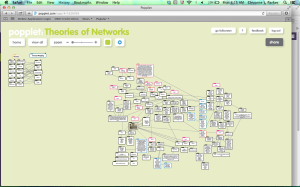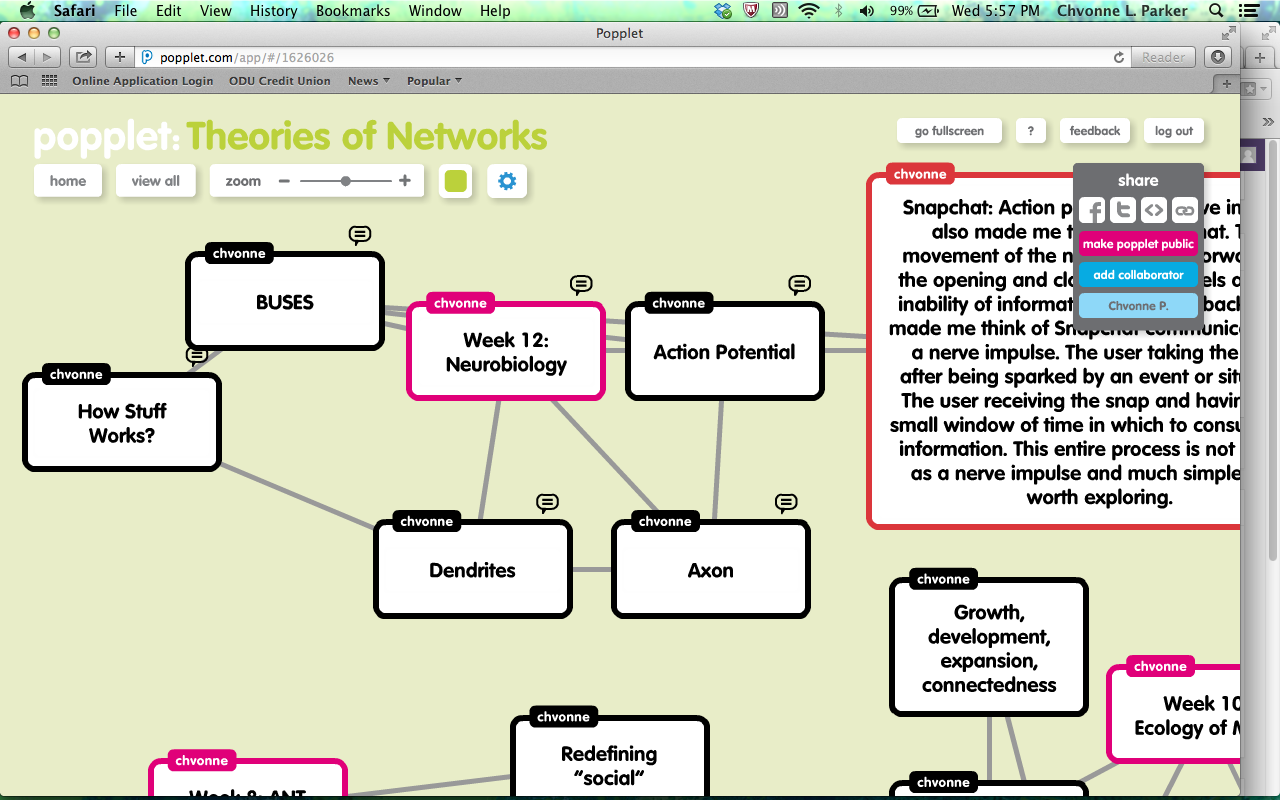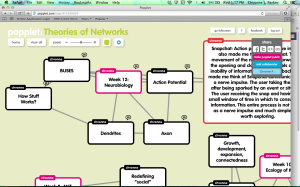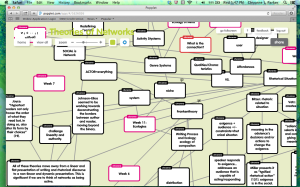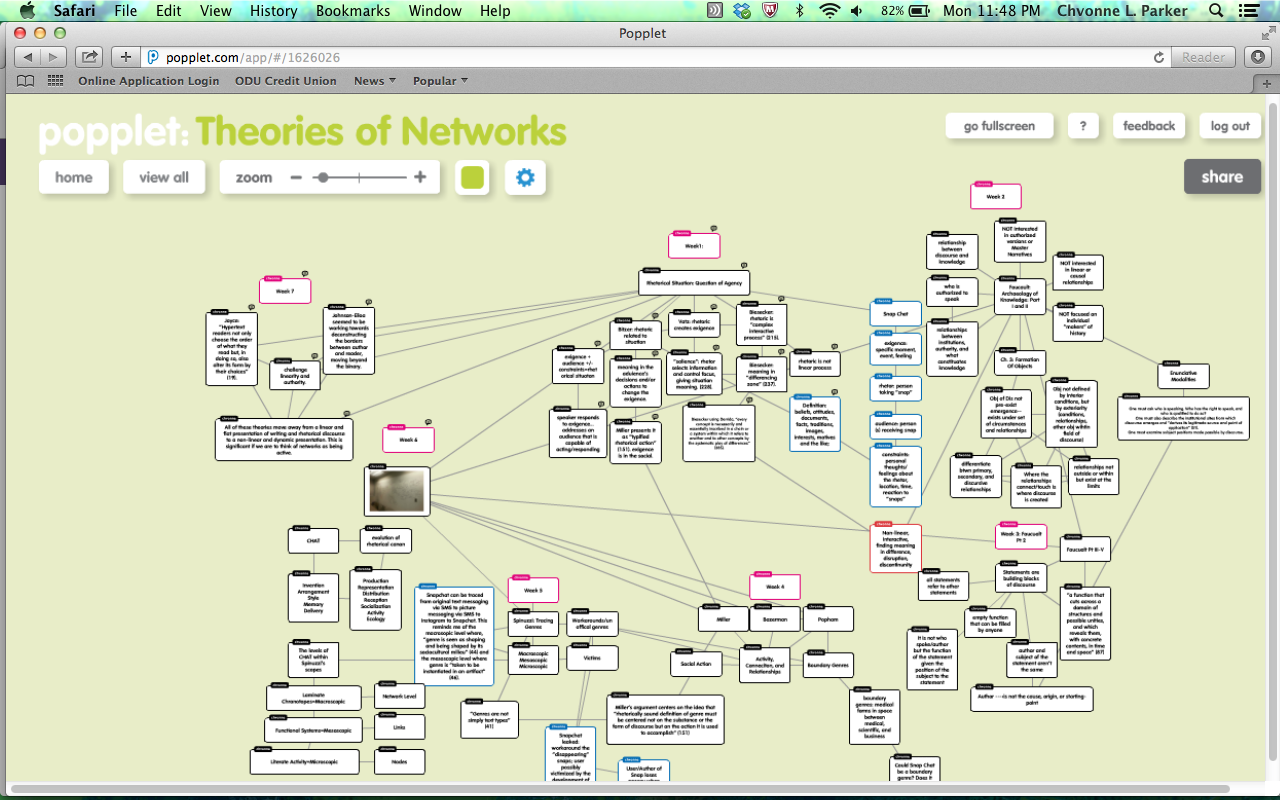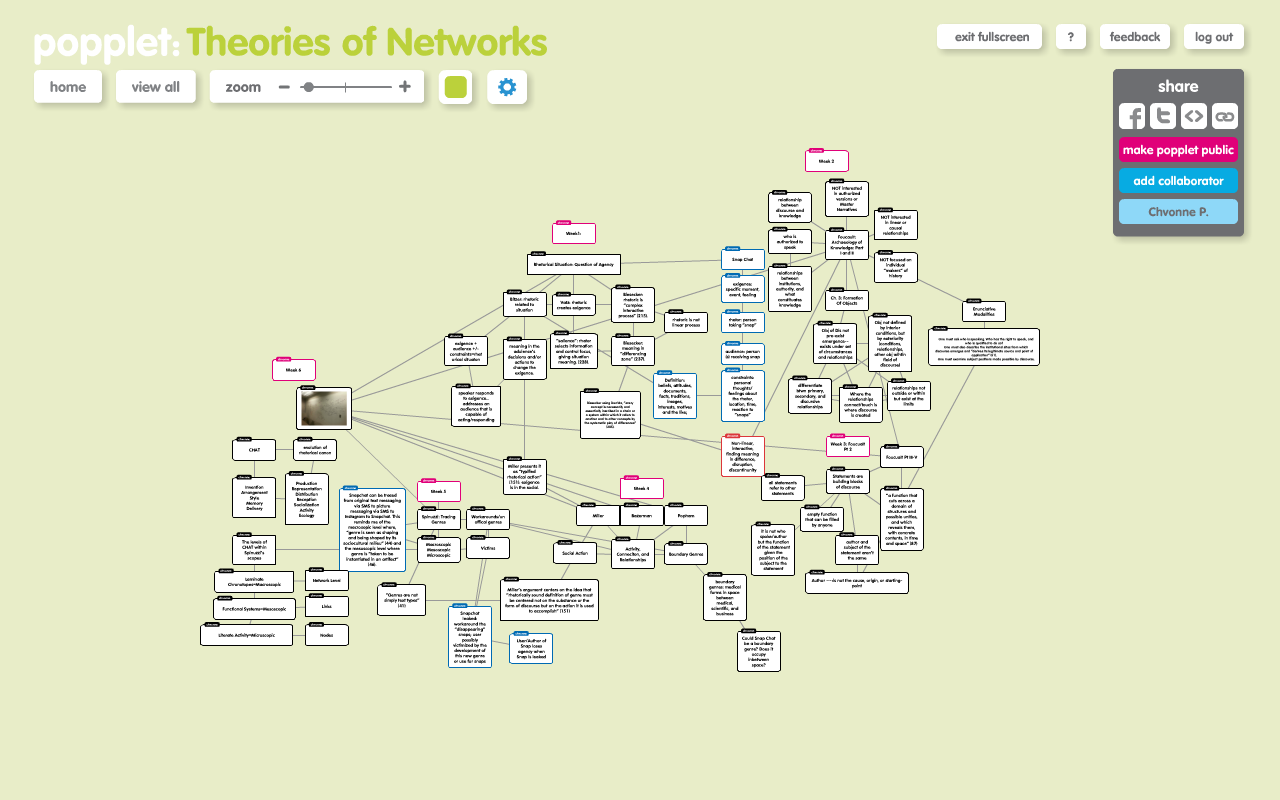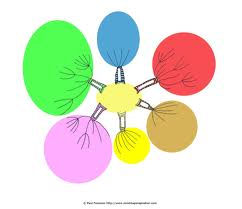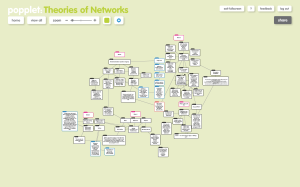Academic Cypher
In hip hop culture, the cypher is a circle of MCs, B-boys/B-girls, beatboxers, etc who freestyle and/or battle one after the other without interruption, exchanging rhymes and flows back and forth or around. The cypher is where training takes place and skills are tested, where people collaborate, and where people create "off the top" or written/choreographed, tapping into the place where thought and action come together to share energy and advance the craft...the Academy should aim to do the same.
Category: MindMap (page 1 of 2)
For the last MindMap, were were to organize our MindMap by concepts. I started this process by listing all the theorists as a guide. After this process, I stopped because I realized that I do not have any concepts by which to group these theorists. So, I went with the things that come to mind when I think of this course: human agency, non-human agency, tracing, and hierarchy.
http://popplet.com/app/#/1626026
The biggest thing I’ve learned from doing the MindMap and the other blogs is that I learn the way I learn and it works for me. This has been the most challenging semester I’ve ever had in my entire life. Even more so than the semester in which I took 2 PhD level classes, my mom passed, and I taught 2 classes at 3 different schools. This entire semester I have been thinking: “There is something wrong with me. I should not be here. Apparently, I am not smart enough to get a PhD.” It took dealing with the MindMap concepts for me to realize what lies at the heart of my issues is my learning style. I am not a visual learner. I have never been in my 30 years of living. I have no desire to be a visual learner, creating this MindMap did not help me to grapple with the concepts presented in the readings. It obfuscated them. Every week I had to push myself to figure out how to condense and connect the things I’d read in order to do the MindMap. I am linear. I like straight lines. I like lists. I like short/concise annotations or long lists with no complete sentences and no visuals. That is how I learn. I like privacy to try out new ideas. This approach, however closed off and inadequate it may seem to others, got me here. I did the MindMap because I had to do it. Do I understand it: No! Am I glad I did it: Yes! I am glad because now I know for certain what works for me and what doesn’t. The processes (MindMap/ Visualize All the Things) felt like steeple chase from my days of track in high school.
This week’s mind map made me regret the week by week layout of my mind map. The week by week mapping has forced me to circle back to the top in order to connect to weeks that are on the opposite side of the screen. Anyhow, I added the following nodes: niche, Frankentheory, ecology of composition/writing process, and distribution,emergence, embodiment, and enaction.
I connected most of these nodes to CHAT, ANT, and Ecologies. These stood out to me because I see Syverson‘s reworking or re-framing of the writing process as being similar to the remapping of the rhetorical canon done by Prior et al. I also felt that this Frankentheory approach was similar to ANT. Actor Network Theory pulls from a variety of areas. It is interdisciplinary even though it centers on re-framing sociology. As I’m writing this, I feel I should have made a node that said re-framing. It seems that much of what we have done in the course focused on re-framing existing ideas or theories flattening them and removing any binaries or dichotomies.
I think these things jumped out at me because I am starting to think that Snapchat may require a Frankentheory approach because the conversations about Snapchat continually frame it as something that it is not, so much so that everyone has just accepted this new conversation as the truth. I think I want to push back against that.
This week’s MindMap was difficult for me because I spent the week at CCCC, which means that productivity was out the window. I attempted to do work every night, but usually I was mentally and physically exhausted. So, I was thrilled to read Norman’s work on affordances. It was clear cut and straight to the point (and I understood every word). This is the first time that has occurred since reading about the rhetorical situation (Week 1). This excitement faded, however, when I read Bateson and realized that I, once again, was not making connections. I have yet to see how affordances connect to Bateson’s ecology of the mind. The focus on environment jumped out to me. I thought that could possibly be looked at in the sense of what the environment affords us (?).
For my mindmap, I added nodes about systems because I saw the ecology as a system/network in the same sense of genre systems, activity systems, and network/hardware systems (from HowStuffWorks?). I made affordances a separate primary node because it functions differently for me, right now. I added the nodes user, designer, qualities/characteristics versus affordances. I focused on the user and designer because of the focus on interface and design in Norman’s article. I also thought about this being a network in the sense that the user, designer, and the affordances are connected and impact one another. I haven’t thought that through just yet. I also focused on the difference between affordances and qualities/characteristics. I was one of those people guilty of conflating the definition of affordances. These nodes will remind me that what a thing affords and it qualities/characteristics are not the same thing.
Latour has been added to the list of people I plan to avoid forever (along with Foucault). I did not enjoy reading about ANT. I have read about and used ANT before in digital humanities; however, I did not read Latour. I cannot remember who I read, but I remember enjoying it. This was not as mentally exhausting as Foucault, but it wasn’t a walk in the park.
As for my mindmap, I added redefining social, actor, and social. I presented these in the sense that the entire first section was focused on redefining social. There was also a focus on expanding on what social sciences can now do. I like the idea of moving away from social being presented in the same way as “wooden.” There is much more to social than a position as a descriptor. Actor was connected to everything (because inanimate things also work as actors). This made me think of the saying: everything is rhetoric and everything’s an argument. I interpreted this more as everything is connected/interrelated than everything is actually an argument/actor/rhetoric.
My additions to this week’s MindMap’s focused on Joyce and Johnson-Eiloa. I was intrigued by the way that hypertext challenged linearity and authority. All of these theories move away from a linear and flat presentation of writing and rhetorical discourse to a non-linear and dynamic presentation. This is significant if we are to think of networks as being active.
Hypertext provides a different perspective on the way in which author and audience interact. The removal of the binary between author and reader.
“Hypertext readers not only choose the order of what they read but, in doing so, also alter its form by their choices” (19).
This was significant in regards to my exploration of Snapchat, wherein I am trying to gain a better understanding of the interactions between user and recipient. How does Snapchat function as a network? Is Snapchat a network?
I connected all of these new nodes to the rhetorical situation (because of the focus on author and reader). I know that connections can also be made with Latour’s ANT; however, I haven’t done the popplets for that theory just yet.
http://popplet.com/app/#/1626026
This week’s MindMap was the easiest of all thanks to Summer. We spent about 2 hours Friday creating a life size MindMap of the theories we’ve explored thus far. Through the mapping activity, we came to the conclusion that all roads lead to Foucault. Foucault’s Archaeology of Knowledge presents a history as network. Each of the theories explored could be seen as archives. I have inserted a picture of our efforts below:
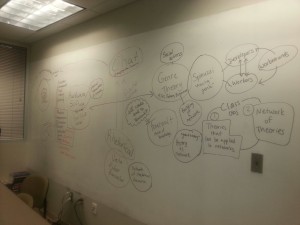 For my digital MindMap, I added nodes for CHAT focusing specifically on the connections between the laminate chronotopes, functional systems, and literate activity and Spinuzzi’s macroscopic, mesoscopic, and microscopic. In my mind, both of these functioned from the abstract to the concrete. With the microscopic and literate activity levels acting as the nodes and the functional systems operating on the mesoscopic level as the links between the nodes. I also made parallel nodes for the classic rhetorical canon and the remapped canon, connecting the elements of the classical canon to the remapped canon. I did not develop all this information out in the popplet in order to save space. Also, I made a connection between CHAT and Foucault. If archaeology is the process for understanding or examining discursive trace of the past to understand and write the present history, the remapping of the rhetorical canon is a tracing of or looking at history in order to understand and transform what is being done in the present.
For my digital MindMap, I added nodes for CHAT focusing specifically on the connections between the laminate chronotopes, functional systems, and literate activity and Spinuzzi’s macroscopic, mesoscopic, and microscopic. In my mind, both of these functioned from the abstract to the concrete. With the microscopic and literate activity levels acting as the nodes and the functional systems operating on the mesoscopic level as the links between the nodes. I also made parallel nodes for the classic rhetorical canon and the remapped canon, connecting the elements of the classical canon to the remapped canon. I did not develop all this information out in the popplet in order to save space. Also, I made a connection between CHAT and Foucault. If archaeology is the process for understanding or examining discursive trace of the past to understand and write the present history, the remapping of the rhetorical canon is a tracing of or looking at history in order to understand and transform what is being done in the present.
I am slowly becoming more and more comfortable with using visuals to develop my ideas. I am seeing this more as a network of different theories of networks. It all starts to be self-referential.
This week’s MindMap update focused on Clay Spinuzzi’s Tracing Genres. I added three nodes and made about three connections. I can see more connections in the work; however, I wanted to think through the connection of Spinuzzi to Foucualt a bit more. The connection to Genre Theory was obvious because Spinuzzi built on the genre work already done by Miller and Bazerman.
I added a node for workarounds, victim, and one with the different levels used in Spinuzzi’s methodology. I was intrigued by the idea the communication and information design overlap. I was also interested in Spinuzzi’s statement: “Genres are not simply text types” (41). These areas interested me because I am trying to think of my Oos whenever I am reading. I hope that this will make the case study a bit less stressful. In regards to SnapChat and the idea of workarounds, I immediately thought of SnapChat’s leaked. This is a website focused on revealing SnapChats. There are also apps to block the notification that user receive if the recipient takes a screen shot of the snap sent. The leaking of snaps has created an new discourse around privacy and leaking. The owner of Snapchat leaked was prosecuted and had to abandon the website. The damage was already done as people began to create apps and plugins to get around the disappearing Snaps.
I created the node with the different levels of scope (microscopic, mesoscopic, and macroscopic) because these will be helpful when making connections between Spinuzzi’s work and the other works we have read. I also think that these are important in examining the way that Snapchat can be traced from original text messaging via SMS to picture messaging via SMS to Instagram to Snapchat. This reminds me of the macrosopic level where, “genre is seen as shaping and being shaped by its sociocultural milieu” (44) and the mesoscopic level where genre is “taken to be instantiated in an artifact” (46).
I am still leaning towards rhetoric as the best way to approach Snapchat. However, the more I read the less committed I am to this approach and the more I’m open to exploring genre and possibly Foucault.
This past week was a breath of fresh air because I was able to take a mental break from Foucault. I needed the step back from Foucault in order to see and understand the connections that are being made. As the course progresses, I am realizing that my internal network is trying to process too much. I sense the connections and see them, but I am unable to articulate them. So, my new approach is to focus on what jumps out at me and to let the other things come to me when my internal network allows.
For this week’s MindMap update, I added a node for Miller, Bazerman and Popham. From there, I was going to add quotes from my notes, but I decided to focus on key words and ideas. I specifically liked the connection between genre as social action and the exigence being social. I realized that action/activity, connection, and relationship are all essential in genre theory. The interactions (or lack thereof), connections, disconnections, exchanges, disruptions, and gaps between all of these are where meaning takes place and things are created or re-created.
An important connection for me was Popham’s boundary genres. The intersection of medicine, business, and science in forms was enlightening. This article helped me to see genres in action. I also began to think about whether or not Snap Chat could be a boundary genre? What intersections could it lie between or among? Considering this expanded definition, I’m realizing that there should be less focus on form and more on what is being done the action and substance. What are people doing with snap chat? How does snap chat help them to do it?
© 2025 Academic Cypher
Theme by Anders Noren — Up ↑
